The Culture Clubs: Researching Communities of Interest cohort
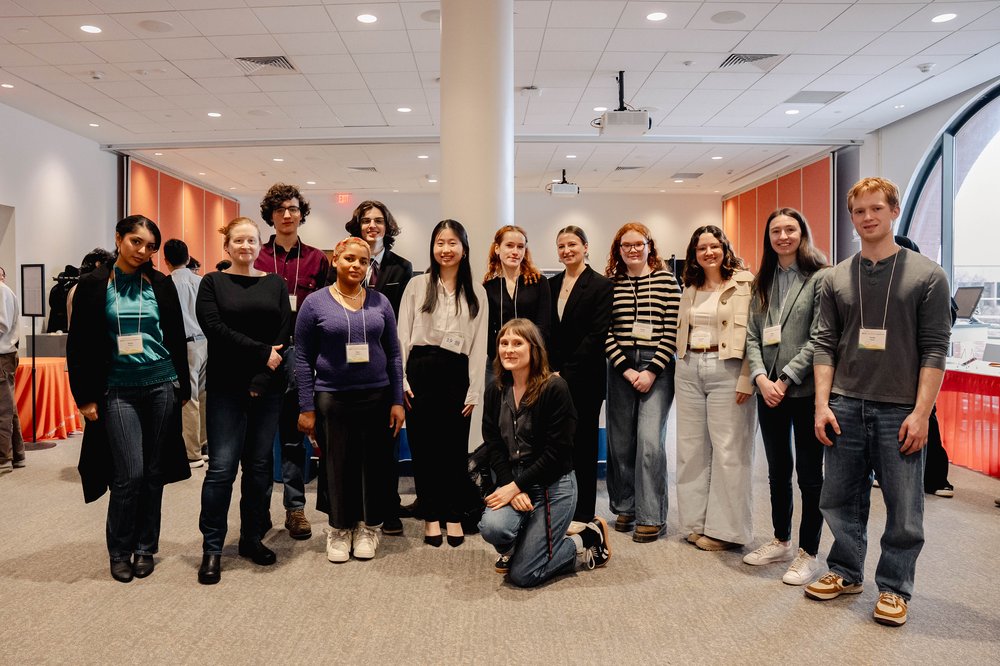
by Amy McDonald, SCRC Reference and Access Services Librarian and Jana Rosinski, SCRC Instruction and Education Librarian
What brings people together into a community? Whether it’s rallying behind a beloved sports team, coming together centered on shared beliefs or ideals, uniting in response through activism or creating a fan club to celebrate an icon of pop culture, people form and seek communities based on what makes us uniquely us. Students in this year’s SOURCE Explore with SCRC cohort looked in our collections for traces of human culture, activity and ideas through archival materials like photographs, scrapbooks and diaries, homemade fliers and pamphlets, notes and ephemera to better understand what constitutes “community” from mainstream offshoots, to counterculture and subculture groups, to organizations of extreme niche interest.
Over the course of this program, students explored an archival collection related to a “culture club” of the past. Based on their individual primary source and contextualizing secondary source research with the community of their choosing, each student created an original zine (a do-it-yourself or DIY, limited-circulation publication) that represented what they uncovered about and connected with their community. At the end of the residency, students presented their work and their experience at a SOURCE research fair along with other concurrent programs and cohorts participating in SOURCE Explore to a small audience of faculty, staff and students. Here is a brief overview of each student’s zine in their own words, along with a photo of them discussing their research with audience members.

Janice Zhang, Syracuse Community Then vs. Now: Housing Edition
Syracuse Community Development Association Records
This all started when I first looked through the Syracuse Community Development Association files from the Special Collections Research Center at Syracuse University Libraries. The collections recorded much of the prevalent issues in the Syracuse City community back in the 1960s. From there, I decided to focus on the housing aspect, as I found it so interesting to be able to compare that resource information to what I see in the city of Syracuse as I live here today in 2025. In addition, I pulled up reliable data from secondary resources from the internet about what the housing situation is like today. Finally, I crafted my zine strategically across multiple parameters to compare housing in Syracuse from the 1960s to now.

Jera Strony, JAWS: A Place of Knowledge for All Women
Journalism and Women Symposium, JAWS newsletter from the Women's Ephemera Collection
Journalism and Women Symposium (JAWS) was created in 1985 by 16 original members. The goal of JAWS is to provide information for women by other women through the form of newsletters. JAWS has worked over the years to create a community for women journalists to hone their craft and bond with other women in their field. Today, JAWS is still up and running, offering membership and retreats for women journalists to create an inclusive environment for all. With my zine, I hoped to display the original look and information of JAWS and how a JAWS newsletter might look now in our current moment, and what I felt would be important to include.
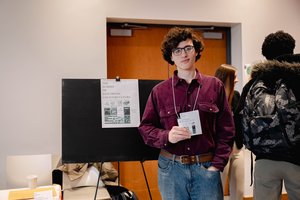
Dan Fenzl, Echoes of Electronic Counterculture
Radical Software by Raindance Corporation
Echoes of Electronic Counterculture examines the relationship between the early adopters of video-based activism in the 1970s and the modern use of digital media for protest and communication. This comparison illustrates there will always be those who push technology to its limits to make their message heard.
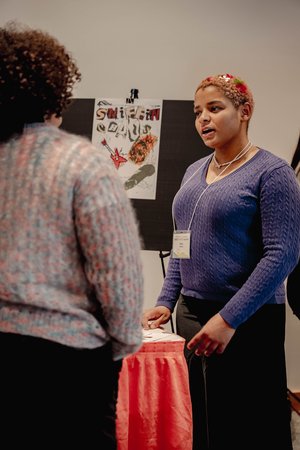
Noor Atkinson, Sniffin' Chaos
I researched the 1976 punk zine Sniffin’ Glue, a raw, DIY magazine that captured the chaotic energy, rebellious spirit and unfiltered opinions of the punk movement. Its rough, photocopied layout, hand-scrawled writing and no-nonsense interviews embodied everything punk stood for—defiance, honesty and a complete rejection of mainstream media. Inspired by its reckless creativity, I created my own miniature version of the zine, keeping the same chaotic, opinionated style but shifting the focus to modern bands I love, rather than strictly punk acts. Instead of just replicating Sniffin’ Glue, I reinterpreted its rebellious essence, proving that the DIY ethos of punk can be applied to any genre, any era and any fan with something to say. After creating my miniature version of Sniffin’ Glue, I dedicated a few pages to analyzing and comparing the writing styles of the original 1976 zine and my own. The original Sniffin’ Glue had a raw, aggressive tone, reflecting the urgency of the time—punk lyrics were filled with anger, frustration and rebellion against the socioeconomic struggles and political corruption of 1970s Britain. In contrast, the bands I wrote about focus more on introspection, self-love and personal struggles, which reflects how modern alternative and indie music often leans into emotional depth rather than political protest. While the original punk zine was an attack on the system, my version became more of an expression of personal taste and identity, proving that while the format and energy of punk live on, the messages behind the music have evolved with time.
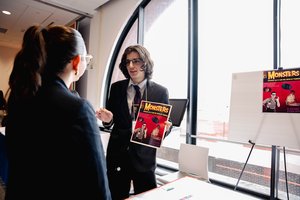
Sam Bevans, Monsters: Horror, Sci-fi, and The Birth of Fandom
"How did fandom become what it is today?" is a question that is often asked as we see labels like "Star Wars Fan" and "Marvel Fan" becoming a part of people's standard identity, as well as the negative ways it has impacted fans and creators alike. While most look to the internet as the answer for how it developed, this zine looks into how a horror/sci-fi magazine might be one of the many examples and answers to this question. We'll look at the history of Famous Monsters of Filmland, reviewing how it was created and evolved from a golden-age horror magazine to one about all contemporary horror and science fiction. We'll witness what spurred its change in focus, along with the problems that arose from the magazine's focus on "monsters" rather than film analysis. We'll finish with a look at how the magazine related to changes in the era's film industry and what conclusions we should take away from this magazine and its impact on modern culture. Ultimately, Famous Monsters of Filmland stands as a key example for understanding how fandom evolved, the passion and problems it’s created and the way we engage with films as art today.
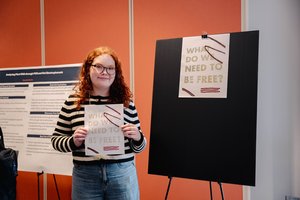
Emma Donohue, 'What Do We Need to Be Free? - Exploring The Reentry Bill of Rights'
The Reentry Bill of Rights: A Blueprint for Keeping Us Free by The Reentry Think Tank
My research focused primarily on how and why the Bill of Rights and the organization that created it came to be and what they are currently doing. In the zine itself I wanted to focus on the interviews with formerly incarcerated individuals represented in the Bill of Rights itself but also explore the other projects that the Reentry Think Tank and The People's Paper Co-op, the organizations that created the artist/activist book, were doing -- like initiatives to support women specifically in reentry from incarceration and ending cash bail -- to find connections. There were many quotes and images in the portfolio that really stood out to me and made me think deeper about these issues, so I chose to highlight them throughout my zine with the hope that people have a similar experience reading as I did. I think prison reform and helping formerly incarcerated people reenter society is a huge issue that is often forgotten about among the many other issues of the world, and I was interested in the concept of using art as a way of raising awareness and advocating for these issues.
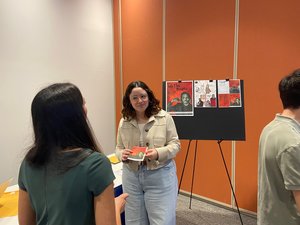
Lorraine Matheu, We The People
The Reentry Bill of Rights: A Blueprint for Keeping Us Free by the Reentry Think Tank
My research delves into the powerful world of art created by current and formerly incarcerated individuals in Pennsylvania. I'm exploring how these artists use various mediums – from drawings and paintings to written expressions like poetry and prose, even full-length books – to translate their experiences with the justice system. Their work offers a unique and heartbreaking perspective on the injustices they've faced, their concerns, and the realities of life behind bars and beyond. It's a way for them to share their stories, challenge perceptions and, ultimately, make their voices heard.
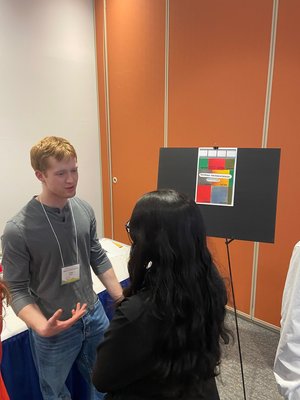
Lucas Dewitt, Reel History: Film Forum at Syracuse
The Film Forum was a student group at Syracuse University in the 1960s, 70s and early 80s. Norman Keim, the founder of Film Forum, wanted to start showing films on the SU campus for students to study and analyze, since film was a growing artistic medium at the time. They held programs to bring in acclaimed filmmakers to host talks and show films. Sadly, they stopped being active in the early 80s and were disbanded in 1983. As a current film student, I wanted to analyze the importance of film at SU throughout its history. Learning about the history of the Film Forum and its impact here at Syracuse gave me a new perspective on what film means here at SU.
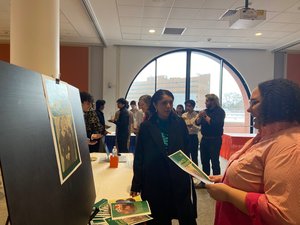
Emily Tenorio, What’s Forward: A View of Fashion and Environmental Culture at SU
University Union at Syracuse University Records and Outer Fringe Society Collection
For my project I looked into the University Archives by way of a scrapbook from 1949-1952 by members of the University Union. When looking through the student activities from over 60 years ago through images and news clippings I came across various reportings of student-run fashion shows. This is what inspired the start of my zine. I was fascinated with how the art and appreciation of fashion and fashion-related events transcend time--how it evolves and grows, but my exploring didn't end there. I came across archives of a club that existed between 1972-1975 called the Outer Fringe Society. Outer Fringe Society initially aimed to replace campus trees lost to Dutch elm disease but later broadened their mission to address larger environmental matters and campus beautification efforts. This club is no longer in existence, but its mission of environmentalist efforts inspired me. I wanted to combine the findings from the past within SU campus culture through the lens of fashion and environmentalism and create a call to action for the future: to combine the culture of both to increase awareness about fashion sustainability within the student body.
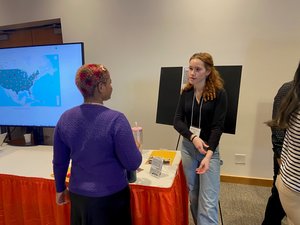
Emily Kozak, Native Rights and Fights
American Indian Movement (AIM) Collection
With my research I focus on Native American rights, policy, protest and key movement figures, primarily in the Northeast region of the U.S. Through highlighting the work of Leonard Peltier among other activists, I bring their legacy into conversation with the issues that persist today. Through my research I learned that this fight for Native rights did not end in the 1900s, it is still going. Many people were killed or jailed for speaking out and protecting their reservations, the only bit of land they had, and I want to bring focus to that.
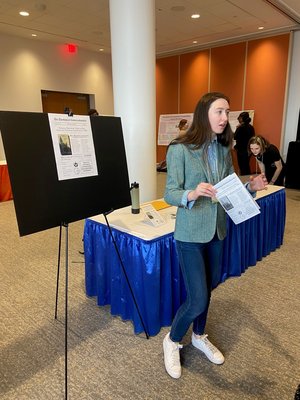
Lillie Kochis, Religious Education Values at May Memorial Unitarian Church in the 1960s
May Memorial Unitarian Universalist Society Records
Extra! Extra! Read all about religious education in the 1960s at May Memorial Unitarian Church in this edition of The Theological Conversationalist. Unfamiliar with Unitarian Universalism? We have you covered. The paper provides a short history of May Memorial and outlines the beliefs of this faith. This edition is a must read for religious officials of any faith. Featuring excerpts from Jo Gould’s “A Guide to the Use of Conversations with Children,” you’ll be left with inspiration to take back into your own classroom. There is unexpected wisdom to be found in these writings of years past. And there’s more! Opinion columnist Lillie Kochis shares where she wished her religious education could have implemented some of these values. Get it while it’s hot!
